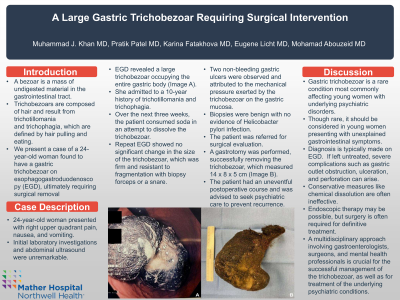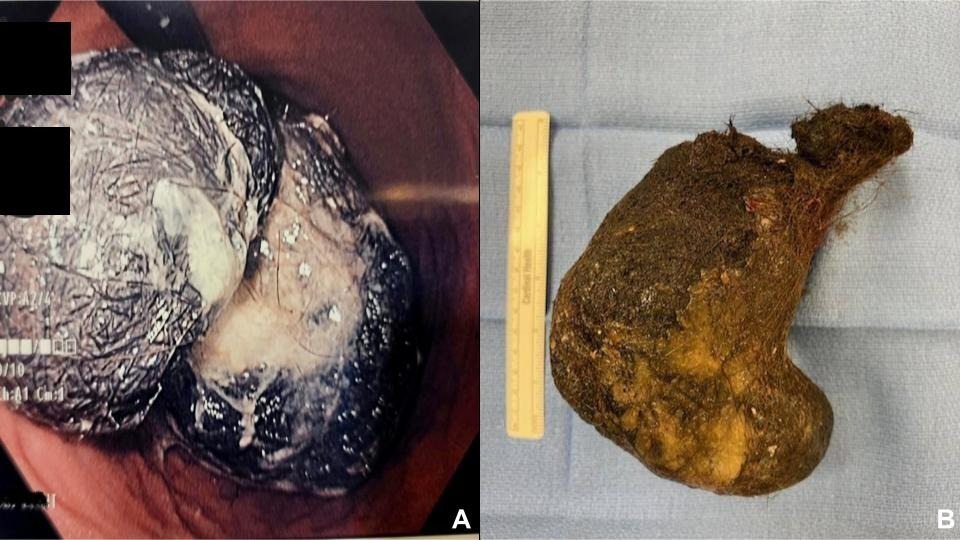Monday Poster Session
Category: General Endoscopy
P2014 - A Large Gastric Trichobezoar Requiring Surgical Intervention
Monday, October 23, 2023
10:30 AM - 4:15 PM PT
Location: Exhibit Hall

Has Audio

Muhammad Jahanzaib Khan, MD
Mather Hospital/Northwell Health
Port Jefferson, NY
Presenting Author(s)
Muhammad Jahanzaib Khan, MD1, Pratik Patel, MD2, Karina Fatakhova, MD1, Eugene Licht, MD3, Mohamad Abouzeid, MD1
1Mather Hospital/Northwell Health, Port Jefferson, NY; 2Mather Hospital/Zucker School of Medicine at Hofstra University, Port Jefferson, NY; 3Mather Hospital/Northwell Health, Setauket, NY
Introduction: A bezoar is a mass of undigested material in the gastrointestinal tract. Trichobezoars are composed of hair and result from trichotillomania and trichophagia, which are defined by hair pulling and eating. We present a case of a 24-year-old woman found to have a gastric trichobezoar on esophagogastroduodenoscopy (EGD), ultimately requiring surgical removal.
Case Description/Methods: A 24-year-old woman presented with right upper quadrant pain, nausea, and vomiting. Initial laboratory investigations and abdominal ultrasound were unremarkable. EGD revealed a large trichobezoar occupying the entire gastric body. Following the procedure, the patient admitted to a 10-year history of trichotillomania and trichophagia.
Over the next three weeks, the patient consumed soda in an attempt to dissolve the trichobezoar. Repeat EGD showed no significant change in the size of the trichobezoar, which was firm and resistant to fragmentation with biopsy forceps or a snare. Two non-bleeding gastric ulcers were observed and attributed to the mechanical pressure exerted by the trichobezoar on the gastric mucosa. Biopsies were benign with no evidence of Helicobacter pylori infection.
The patient was referred for surgical evaluation. A gastrotomy was performed, successfully removing the trichobezoar, which measured 14 x 8 x 5 cm. The patient had an uneventful postoperative course and was advised to seek psychiatric care to prevent recurrence.
Discussion: Gastric trichobezoar is a rare condition most commonly affecting young women with underlying psychiatric disorders. Though rare, it should be considered in young women presenting with unexplained gastrointestinal symptoms. Diagnosis is typically made on EGD. If left untreated, severe complications such as gastric outlet obstruction, ulceration, and perforation can arise. Conservative measures like chemical dissolution are often ineffective. Endoscopic therapy may be possible, but surgery is often required for definitive treatment. A multidisciplinary approach involving gastroenterologists, surgeons, and mental health professionals is crucial for the successful management of the trichobezoar, as well as for treatment of the underlying psychiatric conditions.

Disclosures:
Muhammad Jahanzaib Khan, MD1, Pratik Patel, MD2, Karina Fatakhova, MD1, Eugene Licht, MD3, Mohamad Abouzeid, MD1. P2014 - A Large Gastric Trichobezoar Requiring Surgical Intervention, ACG 2023 Annual Scientific Meeting Abstracts. Vancouver, BC, Canada: American College of Gastroenterology.
1Mather Hospital/Northwell Health, Port Jefferson, NY; 2Mather Hospital/Zucker School of Medicine at Hofstra University, Port Jefferson, NY; 3Mather Hospital/Northwell Health, Setauket, NY
Introduction: A bezoar is a mass of undigested material in the gastrointestinal tract. Trichobezoars are composed of hair and result from trichotillomania and trichophagia, which are defined by hair pulling and eating. We present a case of a 24-year-old woman found to have a gastric trichobezoar on esophagogastroduodenoscopy (EGD), ultimately requiring surgical removal.
Case Description/Methods: A 24-year-old woman presented with right upper quadrant pain, nausea, and vomiting. Initial laboratory investigations and abdominal ultrasound were unremarkable. EGD revealed a large trichobezoar occupying the entire gastric body. Following the procedure, the patient admitted to a 10-year history of trichotillomania and trichophagia.
Over the next three weeks, the patient consumed soda in an attempt to dissolve the trichobezoar. Repeat EGD showed no significant change in the size of the trichobezoar, which was firm and resistant to fragmentation with biopsy forceps or a snare. Two non-bleeding gastric ulcers were observed and attributed to the mechanical pressure exerted by the trichobezoar on the gastric mucosa. Biopsies were benign with no evidence of Helicobacter pylori infection.
The patient was referred for surgical evaluation. A gastrotomy was performed, successfully removing the trichobezoar, which measured 14 x 8 x 5 cm. The patient had an uneventful postoperative course and was advised to seek psychiatric care to prevent recurrence.
Discussion: Gastric trichobezoar is a rare condition most commonly affecting young women with underlying psychiatric disorders. Though rare, it should be considered in young women presenting with unexplained gastrointestinal symptoms. Diagnosis is typically made on EGD. If left untreated, severe complications such as gastric outlet obstruction, ulceration, and perforation can arise. Conservative measures like chemical dissolution are often ineffective. Endoscopic therapy may be possible, but surgery is often required for definitive treatment. A multidisciplinary approach involving gastroenterologists, surgeons, and mental health professionals is crucial for the successful management of the trichobezoar, as well as for treatment of the underlying psychiatric conditions.

Figure: A. Trichobezoar seen in the gastric body on EGD.
B. Surgically removed trichobezoar measuring approximately 14 x 8 x 5 cm.
B. Surgically removed trichobezoar measuring approximately 14 x 8 x 5 cm.
Disclosures:
Muhammad Jahanzaib Khan indicated no relevant financial relationships.
Pratik Patel indicated no relevant financial relationships.
Karina Fatakhova indicated no relevant financial relationships.
Eugene Licht indicated no relevant financial relationships.
Mohamad Abouzeid indicated no relevant financial relationships.
Muhammad Jahanzaib Khan, MD1, Pratik Patel, MD2, Karina Fatakhova, MD1, Eugene Licht, MD3, Mohamad Abouzeid, MD1. P2014 - A Large Gastric Trichobezoar Requiring Surgical Intervention, ACG 2023 Annual Scientific Meeting Abstracts. Vancouver, BC, Canada: American College of Gastroenterology.
